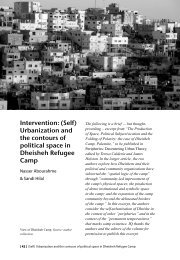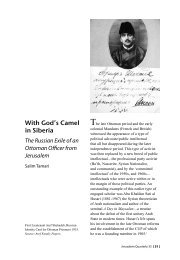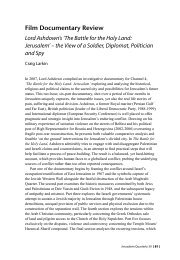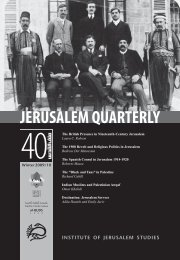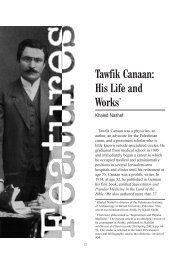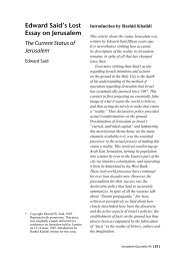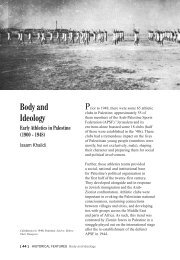PLUNDERING PALESTINE - Jerusalem Quarterly
PLUNDERING PALESTINE - Jerusalem Quarterly
PLUNDERING PALESTINE - Jerusalem Quarterly
Create successful ePaper yourself
Turn your PDF publications into a flip-book with our unique Google optimized e-Paper software.
and thereby devising a comprehensive plan to protect Palestine’s cultural heritage, lies<br />
in a detailed analysis of the situation.<br />
This intervention will focus on four different factors currently threatening cultural<br />
heritage in Palestine. The first is illegal digging of antiquities or what we call<br />
‘subsistence looting’. The second is the impact of the Wall as it continues its<br />
devastating path throughout the West Bank. Third is the impact of antiquity laws,<br />
and finally we consider the impact of the Israeli disengagement plan on Palestinian<br />
heritage.<br />
Illicit Digging: Looting in Your Own Backyard<br />
Illicit digging of antiquities is probably as old as history itself, especially in countries<br />
where human habitation stretches back into the Stone Age, as it does in Palestine. This<br />
problem has been intensified in Palestine by decades of political instability and foreign<br />
rule. According to a 1930s British Mandate survey, historic Palestine (Israel, the West<br />
Bank & Gaza Strip) has a total of more than 35,000 large and small archaeological<br />
sites (caves, ruins, tells, sanctuaries, quarries, towers, churches, mosques, etc.) from<br />
all historic and prehistoric periods. The West Bank alone has about a third of those<br />
sites (12,217) (see table below), many of which have been destroyed, particularly<br />
since the occupation of the West Bank by Israel in 1967. The exact number of sites<br />
robbed in the occupied territories since then is unknown, but it is estimated to be in the<br />
thousands. 1 Grave robbers have even vandalized Moslem tombs like Maqam Hasan<br />
al-Rai’ near Nabi Musa, although such tombs are known not to include burial goods of<br />
any kind.<br />
Identified West Bank Archaeological Sites and Features as of the 1930s<br />
No.<br />
of District<br />
Name<br />
of District<br />
Size<br />
of District<br />
in km 2<br />
No.<br />
of villages<br />
No.<br />
of main sites<br />
No.<br />
of features<br />
Total No.<br />
1 Bethlehem 581 71 136 1,228 1,364<br />
2 Gaza 371 42 44 140 184<br />
3 Hebron 1,068 156 357 1,859 2,216<br />
4 Jenin 586 96 212 537 749<br />
5 Jericho 649 16 76 451 527<br />
6 <strong>Jerusalem</strong> 332 51 181 1,386 1,567<br />
7 Nablus 569 73 266 1,015 1,281<br />
8 Qalqilya 151 35 53 418 471<br />
9 Ramallah 782 80 347 1,788 2,135<br />
10 Salfit 201 23 86 662 748<br />
11 Tubas 415 23 130 359 489<br />
12 Tulkarm 263 42 100 385 485<br />
Total 12 5,968 708 1,988 10,228 12,216<br />
[ 40 ] FEATURES VieLooting and ‘Salvaging’


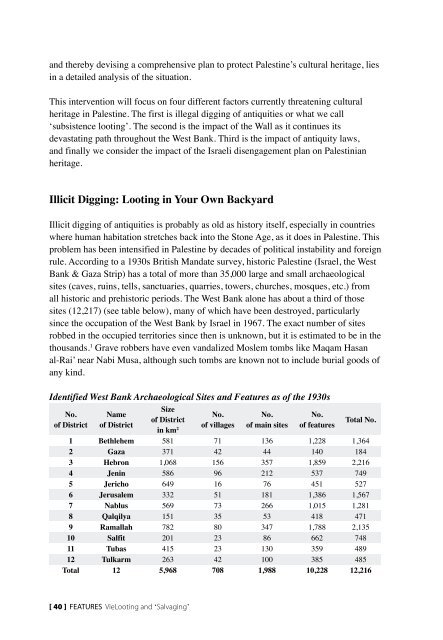
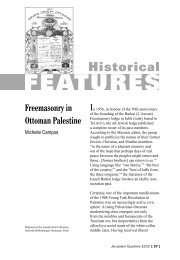
![In Search of Jerusalem Airport [pdf] - Jerusalem Quarterly](https://img.yumpu.com/49007736/1/180x260/in-search-of-jerusalem-airport-pdf-jerusalem-quarterly.jpg?quality=85)
